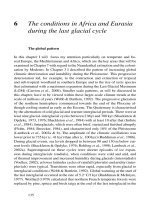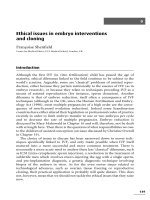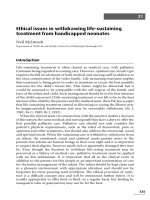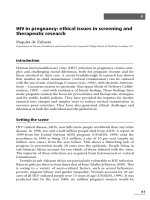HIV in pregnancy - ethical issues in screening and therapeutic research
Bạn đang xem bản rút gọn của tài liệu. Xem và tải ngay bản đầy đủ của tài liệu tại đây (273.32 KB, 26 trang )
4
HIV in pregnancy: ethical issues in screening and
therapeutic research
Paquita de Zulueta
Department of Primary Healthcare and General Practice, Imperial College School of Medicine, London, UK
Introduction
Human immunodeWciency virus (HIV) infection in pregnancy creates com-
plex and challenging moral dilemmas, both for pregnant women and for
those involved in their care. A recent breakthrough in research has shown
that mother-to-child transmission (vertical transmission) can be reduced
with the use of anti-viral drugs (Connor et al., 1994), with obstetric interven-
tions – Caesarean section in particular (European Mode of Delivery Collab-
oration, 1999) – and with avoidance of breast-feeding. These Wndings have
made pregnant women the focus for preventative and therapeutic strategies,
and for public health policies. They have provided the impetus for further
research into cheaper and simpler ways to reduce vertical transmission in
resource-poor countries. They have also generated ethical challenges and
dilemmas at both the individual and the global level.
Setting the scene
HIV-related disease, AIDS, now kills more people worldwide than any other
disease. In 1998, two and a half million people died from AIDS. A report in
1999 from the United Nations AIDS program (UNAIDS, 1999) cited the
prevalence in 1998 as being 33.4 million, a rise of 10 per cent (nearly six
million new cases), from the year before. This shows a disturbing lack of
progress in prevention nearly 20 years into the epidemic. People living in
sub-Saharan Africa account for two-thirds of those infected with the virus.
The majority of these infections are acquired from heterosexual or vertical
transmission.
Females in sub-Saharan Africa are particularly vulnerable to HIV infection.
Rates in girls are three to four times that of boys (Malloch Brown, 2000). This
is owing to a variety of socio-cultural factors, such as sexual behaviour,
poverty, migrant labour and gender inequality. Women account for 43 per
cent of all HIV-infected people over 15 years of age (UNAIDS, 1999). It was
predicted that by the year 2000, six million pregnant women would be
61
infected with HIV (Scarlatti, 1996). HIV infection is transmitted to 15–25 per
cent of babies born to HIV-infected women in Europe and America, and to
25–35 per cent of those born in Africa, India and Thailand (Peckham and
Gibb, 1995; Newell et al., 1997).
The majority of children acquire HIV infection from their mothers, such
that the number of infected children parallels the number of infected women.
The United Nations reported that in 1997 there were approximately 600 000
babies infected annually with HIV-1 through vertical transmission – about
1600 daily – and that 90 per cent of these were born in Africa (UNAIDS,
1998a). In fact, according to Peter Piot, executive director of the UNAIDS
agency, half of all newborn babies in Africa carry the HIV virus (Anonymous,
1999a).
This exceedingly bleak outlook is relieved in part by the discovery that the
following measures can reduce vertical transmission:
∑ Avoidance of breast-feeding decreases transmission after birth by about 14
per cent (Dunn et al., 1992).
∑ More importantly, the large randomized controlled trial conducted by the
Paediatric AIDS Clinical Trial Group (PACTG) in 1994 showed unequivo-
cally that perinatal treatment with an anti-viral drug, zidovudine (AZT),
signiWcantly reduced vertical transmission of the HIV virus by about two-
thirds in more developed countries – from around 25 per cent to 8 per cent
(Connor et al., 1994).
∑ Furthermore, reWning anti-viral therapy and selectively performing plan-
ned Caesarean section has given even better results (European Mode of
Delivery Collaboration, 1999).
∑ Vitamin supplements have not been clearly shown to reduce transmission,
but have improved the adverse pregnancy outcomes associated with HIV
infection in resource-poor countries (Fawzi et al., 1998).
In fact, provided that the resources are available, vertical transmission rates
can now be reduced to less than two per cent (Tudor-Williams and Lyall,
1999). In other words, vertically acquired HIV is a near-preventable condi-
tion.
In the aZuent, developed countries, up to 1994, HIV-positive women were
faced with the grim choice of either continuing with a pregnancy that carried
a 1:5–6 risk of their oVspring being infected (if bottle-fed), or of having a
termination. In addition, until the advent of highly active retroviral treat-
ment (HAART) in the mid-1990s, the prognosis for an HIV-infected individ-
ual was bleak. Women found to be HIV- positive faced the prospect of a fatal
progressive illness. (The time taken for AIDS to develop can vary greatly – the
average is around nine years.) But now HIV-infected individuals in these
countries can hope for an increased longevity, with the maintenance of an
independent, reasonable quality of life for several years (Cohn, 1997). Never-
theless, they need to take complex regimes of three or more anti-viral drugs
62 P. de Zulueta
(de Cock, 1997), with many adverse eVects. Some people have diYculty
tolerating the treatment physically or psychologically. The disease, albeit
more controllable, remains incurable. This has important ethical implica-
tions – sometimes overlooked in the discussion of perinatal HIV. Neverthe-
less, pregnant women in these countries can at least be conWdent that their
oVspring can escape infection, and, that if they accept treatment, they
themselves may beneWt from earlier diagnosis (de Cock and Johnson, 1998).
It is a tragic irony, however, that the countries with the highest prevalence
tend to be those with the fewest resources to combat the disease – 19 out of 20
people infected with HIV cannot beneWt from HAART. The majority of
pregnant women cannot beneWt from these modern, evidence-based treat-
ments and interventions.
For those living in developing countries, the new treatments are virtually
unobtainable owing to prohibitive costs (Anonymous, 1998; UNAIDS,
1998a; Bayley, 2000; Cochrane, 2000). For example, the 076 regime costs
$1000 in the United States. Many countries in sub-Saharan Africa spend as
little as $6 a year for health care per person per year (Bayley, 2000; Cochrane,
2000).
In resource-poor countries, antenatal care itself may be minimal or non-
existent (Graham and Newell, 1999; Marseille et al., 1999; Mofenson, 1999).
The cost and complexity of AZT treatment, according to the PACTG 076
protocol, makes it unobtainable for countries that may only be able to spend
a very small percentage of their gross national product (GNP) on health care.
It is only those who participate in trials (or the very privileged) who stand a
chance of receiving prophylactic therapy.
Hence the majority of HIV- positive women living in poor countries face
the prospect of bringing into the world children who may be infected, or
orphaned at an early age.
Even reproductive choices may be limited. In some countries, women are
expected to bear children, and fecundity is associated with high status.
Partners do not often collaborate in reducing risks and conceptions (Schott
and Henley, 1996).
Studies in the early 1990s in Kenya and other African countries have shown
that the epidemic has had little impact on attitudes and subsequent child-
bearing (Ryder et al., 1991; Temmerman et al., 1995). Political-will to
confront the problem has also been slow to manifest itself in many African
countries. But there are signs of change (Altman, 1999). It is disappointing
that at the time of writing, President Mbeki of South Africa appears to be
reversing this positive trend. Rather than endorsing a programme of national
funding for perinatal zidovudine (prevalence in pregnant women is around
one in Wve), he is exploring the evidence for AIDS not being caused by HIV –
a very unorthodox view (Anonymous, 2000a).
In conclusion, the gross inequity in resources, particularly in health care
63HIV in pregnancy
provision, that exist today between the aZuent and the poor countries is
brought into sharp focus by the contrasting fates of those with HIV. There
are, however, some hopeful signs of progress. The UN Security Council,
chaired by the vice-president of the USA, convened in January 2000 to
discuss actions to tackle the problem of AIDS – the Wrst time that a health-
related issue has ever been discussed. Pharmaceutical countries have agreed
to reduce the costs of their drugs for distribution in some poorer countries
(Anonymous, 1999b). The World Bank has pledged its support (Anony-
mous, 1999c; Cochrane, 2000). In addition, some countries, such as Uganda
and Senegal, have managed to reduce transmission by vigorous public health
education programmes (Anonymous, 2000b).
HIV testing and screening in pregnancy
The discovery that vertical transmission can be reduced has had a major
impact on named-testing policies in countries where resources are available
to implement preventative measures. Before 1994, anonymized antenatal
unlinked HIV screening, or surveillance, had already been widely adopted by
public health and political institutions in several countries, in order to
monitor the prevalence of HIV in the antenatal community (Heath, Grint
and Hardiman, 1988; Peckham et al., 1990; Hudson et al., 1999). For
example, in the UK, it began in 1990, as part of the Department of Health’s
Unlinked Anonymous HIV Prevalence Monitoring Programme, and con-
tinues until the present day. Pregnant women are considered an ‘epi-
demiological useful’ group because they represent a stable sub-group of the
heterosexually active population at ‘normal risk’. They are usually in regular
contact with health professionals, and have blood tests taken routinely.
I shall now consider the potential implications of a positive result, the
nature of the relationship between the health professional and the pregnant
woman, and the process of consent, as these are all relevant to a discussion
about the ethics of anonymized and named testing.
The implications of a positive result
A pregnant woman is likely to experience considerable distress on discovery
of her positive status (Manuel, 1999), particularly as she may feel more
vulnerable and dependent on others, and she has the added responsibility of
motherhood ahead of her. She may contemplate real risks of rejection from
her partner, family and friends.
For those working, employment may be put into jeopardy. Life or medical
insurance may be diYcult to obtain.
In a resource-rich country, if a pregnant woman does agree to HIV testing,
64 P. de Zulueta
the assumption is that if she proves to be HIV-positive, she will comply with
the treatments to prevent vertical transmission. This assumption has been
borne out by empirical research (Gibb et al., 1997; Lyall et al., 1998). A
woman, however, may not be aware of the chain of events that will proceed
from the discovery of a positive status in pregnancy. In addition to taking
anti-viral treatment, she may be advised to have a planned Caesarean section.
Some women may object. In English law, the competent woman’s right to
refuse treatment is absolute, even if her fetus is put at risk from her decision.
Once born, however, the interests of the child are paramount, and parental
views may be overridden if they are seen to conXict with the child’s welfare.
Babies can still gain protection from infection if given antiviral treatment
within 48 hours of birth, even if the mother has refused to take medication or
have a Caesarean section (Wade et al., 1998).
If a woman is known to be HIV-positive, health professionals may recom-
mend that her recently born child is tested for HIV, arguing that it is in the
best interests of the child. Diagnosis can now be made as early as one to three
months of age (Corbitt, 1999), and early diagnosis leads to improved progno-
sis (Evans et al., 1995; Richardson and Sharland, 1998). The infected child,
without treatment, usually survives only Wve years or less in developing
countries. With treatment, survival may be until the age of 15, or beyond.
Parents might not wish for their child to be tested. Knowledge of their child’s
positive status could have a profoundly negative impact on their relationship
with him or her. It is beyond the scope of this discussion to consider the
poignant dilemma for parents of whether or not to disclose to their child his
or her incurable infection and uncertain life expectancy, or to explore the
burden of imposing life-long unpleasant treatment on a child, and of protect-
ing him or her from stigma.
A British legal case in September 1999 highlighted the diYculties (Anony-
mous, 1999d; Verkaik, 1999). A woman, known to be HIV- positive, gave
birth. She had not taken anti-retroviral treatment in pregnancy and had
breast-fed from birth. There was therefore a signiWcant risk (20–25 per cent)
that the child would be infected. Health professionals were alarmed. The
couple refused to have their child tested for HIV. They did not believe that
HIV was an infection that responded to antiviral treatment. Social Services
made an application under the 1989 Children Act. The child (now four
months old) was made a ward of court, and the court overruled parental
refusal and ordered the test. If the child tested positive, treatment was to be
instituted. The woman, however, was not ordered to stop breast-feeding. The
couple Xed the country with their child. Had the child been found to be
HIV-positive, one can speculate on the diYculties in implementing a com-
plex anti-viral regime with non-compliant parents.
HIV-positive mothers in developed countries are advised to abstain from
breast-feeding, but guidelines for women respect their right to make a choice
65HIV in pregnancy
(Department of Health, 1999). It is evident from the case above, however,
that women may Wnd that breast-feeding causes disapprobation, and may
even result in their infants being considered ‘at risk’. Decisions regarding
their child’s welfare may then be taken out of their hands. Abstention from
breast-feeding creates particular diYculties in countries and cultures where
breast-feeding is the norm, and bottle-feeding stigmatizes a woman (Graham
and Newell, 1999). In addition, bottle-feeding may be risky in areas where
hygiene is low and may be prohibitively expensive (UNAIDS, 1998b).
Voluntary named testing poses particular ethical problems in poorer
countries (Temmerman et al., 1995; Karim et al., 1998). HIV prevalence may
be considerably higher in some of these countries, such that in theory the
cost-eVectiveness of screening is correspondingly much greater than in the
aZuent countries (Marseille et al., 1999; Postma et al., 1999; Soderlund et al.,
1999). But without the resources for treatment, as is often the case, the
beneWts to women are less clear. Knowledge of HIV status may be particularly
burdensome to those living in some countries, creating not only stigma and
social isolation, but also abandonment or violence from partners and/or
family (Temmerman et al., 1995; Duke, 1999; McGreal, 1999; Wiktor et al.,
1999). HIV testing in this context should not be undertaken without provid-
ing counselling and support. The women can be given strategies to help cope
with the disease, prepare for the future, reduce risk behaviour and make
reproductive choices. But as one researcher expressed it: ‘There is not much
that we can oVer African women once we have told them the bad news’
(Temmerman et al., 1995: p. 970).
Even if women accept testing, they do not necessarily wish to receive the
result. Presumably this is owing to the risk of stigma and social discrimina-
tion. Temmerman et al. (1995) found that most of the women participating
in a research trial in Kenya did not actively request their test result. One-
quarter dropped out of a research study once they learnt they were test-
positive. This has been a common Wnding in research studies in Africa (Dabis
et al., 1999; Guay et al., 1999; Wiktor et al., 1999).
The relationship between the health professional and the patient
As I have discussed elsewhere (de Zulueta, 2000a), the relationship between a
health professional and a patient can be characterized as a Wduciary one.
Respect for a patient’s autonomy cannot be divorced from acting in her best
interests, as it is usually the patient who knows what is best for her. Others
share this view. For example, Pellegrino and Thomasma (1988: p. 55),
both professors of medical humanities, say: ‘Respecting wishes of patients
is an essential feature of acting in their best interests’. Margaret Brazier, a
professor of law, and Dr Mary Lobjoit (Brazier and Lobjoit, 1999) also
endorse the notion of the Wduciary relationship between the health profes-
66 P. de Zulueta
sional and the patient, and describe it as a therapeutic alliance or partnership.
The health professional is therefore entrusted to put the patient’s interests
Wrst, and to hold certain things (such as conWdential information) ‘in trust’.
As Brazier succinctly expresses this: ‘It is trite to describe the health profes-
sional’s relationship with his or her patient as a relationship of trust, yet the
description encapsulates the very heart of the relationship’ (Brazier and
Lobjoit, 1999: p. 187). The health professional has a duty to promote the
well-being of both the mother and the unborn child, but should only provide
care that the mother agrees to. The woman, as an autonomous agent, confers
on the fetus the status of being a patient (McCullough and Chervenak, 1994).
If we believe that respect for autonomy is a fundamental principle in health
care, then we should give pregnant women the opportunity to know their
HIV status. ‘The information is material to making informed choices about
her own and her baby’s future’ (Boyd, 1990: p. 176). Pregnant women are not
typical patients. They are not ill, but are undergoing a normal physiological
process. They voluntarily seek help from health professionals to maximize
their own and their baby’s welfare. Arguably it is even more of an imperative
to respect their autonomy.
Consent
The importance accorded to patient consent reXects the respect with which
health professionals regard their patients. Consent can be deWned as both a
legal and an ethical requirement. Failure to seek the patient’s consent is not
only a moral failure, but, in English law, also leaves the doctor liable to the
tort or crime of battery or to the tort of negligence. For consent to be legally
valid, it must be competent, informed and voluntary. The information
required is such that the patient understands in broad terms the nature and
purpose of the procedure, and the principal risks, beneWts and alternatives
(Chatterton v Gerson, 1981). Voluntariness implies freedom from coercion.
Consent is a process, not an event, and involves a continuing dialogue
between the health care professional and the patient, such that there is
genuine shared decision-making. Patients should control the amount and
timing of information. I submit that in the case of anonymized testing, and in
the case of ‘routine’ voluntary named testing, consent is often vitiated by a
lack of understanding and information, and sometimes by coercion.
The ethics of anonymised unlinked screening for HIV in
pregnancy
With anonymized testing, there is a tension between the perceived interests of
society (the public good) and those of the individual. The conclusion taken
67HIV in pregnancy
by the working party of the UK Institute of Medical Ethics (IME), that the
beneWt to the public from anonymized testing outweighs any individual
harm (Boyd, 1990), is no longer tenable.
Despite the fundamental therapeutic change for pregnant women (at least
in resource-rich countries) since 1994, anonymous antenatal testing inexor-
ably continues in the UK and in several other developed countries (Nicoll et
al., 1998). This may be justiWed in countries where the resources are not
available to oVer counselling or treatment, and where the data may be used to
galvanize the developed world into providing aid. It seems harder to justify in
wealthy countries. In fact, anonymized testing has been abandoned in some
places, as it is considered unethical (Richards, 1999). So what are the current
justiWcations?
Anonymized testing provides accurate prevalence Wgures relatively cheaply
and easily. These Wgures, it is argued, can then be used to provide the
justiWcation for allocating more resources to the treatment and prevention of
the disease, particularly in areas of high prevalence. They can also provide
information as to the cost-eVectiveness, or desirability, of oVering voluntary
named testing. They provide valuable information for health educators and
health professionals. Public health physicians and HIV specialists argue that
there is a continuing need to monitor prevalence and trends, as these may
change (Pinching, 2000; Nicoll and Peckham, 1999), and that the data can be
used to audit the success of a voluntary named testing programme. These
arguments are persuasive, but they fail to take into account the professional’s
duty of care.
Another justiWcation that appears in the literature is the proposal that
consent to having a blood test implies consent to having it tested for HIV,
and that the patient has given her blood away and has no property rights over
it. This is dismissed by Brazier as a red herring. She points out that the when
the blood is taken, the intention is always to test it for HIV, and that the
patient should be informed of this. It could be argued that it is up to women
to decide whether they wish to have an HIV test done anonymously. But I
would counter-argue that it is unprofessional and unethical to encourage
individuals to relinquish beneWts that may aVect third parties (human
fetuses), even if these are not ‘legal persons’. Grubb and Pearl (1990) take the
view that public policy should deny women this opportunity.
Finally, it could be argued that if an informed mother agrees to anony-
mized testing, she does not intend to deprive the fetus of beneWt, as she does
not know if she harbours the virus. This argument is also used to justify the
health professional’s behaviour – no harm is intended, and there is no
responsibility to act upon the result since it is unobtainable. But a profes-
sional cannot abrogate his or her duty to inform the mother of the beneWts of
diagnostic testing. If we consider other instances of screening, such as cervical
screening, or, more appropriately, genetic screening for susceptibility to a
68 P. de Zulueta
treatable cancer, it would seem bizarre and immoral if professionals sugges-
ted to patients that they should not receive the results of such tests.
Anonymized testing may represent an abuse of trust in the health profes-
sional. A woman attending an antenatal clinic carries the reasonable expecta-
tion that all tests and procedures are done either directly to beneWt her or her
unborn child (de Zulueta, 2000a). This assumption is reinforced if the test is
done by a health professional, precisely because the relationship is one of
trust. As one mother poignantly expressed it: ‘But surely if they found
something wrong they’d tell you, wouldn’t they?’ (Kahtan, 1993). Policy-
makers exploit this trust in obtaining blood for anonymized testing.
All babies in the UK and several other countries have blood taken for the
Guthrie test at around six days after birth (the heel prick test). Some of this
blood is used for anonymized testing of maternal antibodies to HIV. The
baby is used as a vehicle for testing the mother. It is accepted practice not to
seek parental consent. The case for abuse of trust is even stronger than with
anonymized testing of pregnant women, as the mothers are even more likely
to assume that all tests are for the baby’s beneWt. Since the baby relies entirely
on others to protect his interests, it is arguably even more unethical to use the
baby ‘merely as a means, rather than as an end in himself’, to paraphrase
Kant.
In order to make an informed choice, the woman needs to understand the
nature of the test itself, as well as the advantages and disadvantages of not
receiving the result should it be positive. Kennedy and Grubb (1994) take the
view that the doctor’s duty to inform may extend to informing a patient of
the risks of non-treatment. They cite a case when a doctor was found in
breach of duty for failing to inform a woman of the potential consequences of
not agreeing to a cervical smear.
Are antenatal women adequately informed to give valid consent to anony-
mized testing? The IME took the view that the widespread distribution of a
leaXet published by the Department of Health and Central OYce of Informa-
tion (1989) ‘largely satisWed’ their recommendations that it gave patients
adequate information and allowed them the option to refuse (Boyd, 1990:
p. 176). But this assumes that women read the leaXets, and that they are in a
language which they can understand. In addition, the leaXet issued by the
Department of Health, in circulation after 1994, does not refer to treatments
available for reducing vertical transmission. Nor does it refer to the risks of
breast-feeding. In any case, the notion of passive consent, that is to say that
consent is implied unless there is a verbal refusal, is ethically unsound and ‘a
concept quite alien in English law’ (Brazier and Lobjoit, 1999: p. 183).
Some statements make it clear that policy-makers actually do not wish for
informed consent (Department of Health, 1997: p. 73). In clinics that pro-
vide universal testing (see later), the women should have received the
relevant information from a pre-test discussion with the midwife, and the
69HIV in pregnancy
opportunity to have a named test. But the contradiction in undertaking both
named and anonymized tests is striking. ‘On the one hand she is receiving the
strong message that she should accept testing ‘‘for the good of her baby’’. Yet
on the other hand she is being asked to accept testing whereby she and her
baby cannot beneWt!’ (de Zulueta, 2000b: p. 25).
Do women understand the nature and purpose of antenatal testing?
Anecdotal and empirical evidence (Kahtan, 1993; Chrystie et al., 1995) shows
that the majority of women do not understand anonymized testing. In
addition, it is doubtful that all women know that their blood is being tested
anonymously for HIV. In one study only Wve per cent fully understood the
nature of the testing, and a signiWcant proportion believed that they would be
informed should the result be positive (Chrystie et al., 1995).
The standards committee of the General Medical Council in 1988 took the
view that unlinked anonymous HIV testing breached no fundamental ethical
principle (Anonymous, 1988). In the light of my arguments, this statement
can no longer be upheld. The principle of autonomy is frequently infringed
by the process of anonymized testing, and, as Brazier says, ‘Consent truly is a
myth’ (Brazier and Lobjoit, 1999: p. 179). The moral justiWcations for violat-
ing autonomy are considerably weakened by the knowledge that there are
methods to prevent vertical transmission. Women must be made aware that
by relinquishing the opportunity to receive the result of the HIV test, they are
depriving themselves and their future children of potential beneWt.
The ethics of named testing
The Department of Health’s Unlinked Anonymous Surveys Steering Group
in 1989 rejected mass voluntary testing as an alternative to anonymized
testing. The harms of voluntary named testing – social discrimination, stigma
and the lack of a curative treatment if found to be HIV-positive – were
considered to outweigh the beneWts. Gill, a consultant epidemiologist, and
colleagues, summarized the position against voluntary testing in 1989: ‘If the
necessary HIV surveys use the universal named case Wnding method they will
be complex, expensive, and subject to participation bias. They may cause
considerable and avoidable distress in populations with very low preva-
lence’(Gill et al., 1989: p. 1296). This statement appears to be borne out by
empirical evidence. The uptake for anonymized testing in the UK in 1996 was
99.9 per cent, but below 25 per cent for voluntary named testing (Gibb et al.,
1998). This paternalistic practice of withholding the truth is now viewed as an
infringement of patient autonomy. Furthermore, empirical evidence shows it
to be contrary to the wishes of most patients (Novack et al., 1979; Buckman,
1996). As argued above, the beneWts of named testing, and the arguments in
favour of truth-telling are further strengthened, particularly as third parties
are placed at risk by non-disclosure.
70 P. de Zulueta









